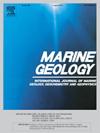Mesophotic encrusting biotas and bioclastic deposits on the Western South Atlantic Equatorial margin: Geomorphological insights from the Amazon and Semi-Arid Coast Systems
IF 2.2
3区 地球科学
Q2 GEOSCIENCES, MULTIDISCIPLINARY
引用次数: 0
Abstract
Encrusting mesophotic biotas shaped by interactions between organisms, sedimentary processes, and environmental factors contribute significantly to bioclastic sediment compositions. This paper focuses on their distribution and relationship to deposits on the Western South Atlantic Equatorial Margin, particularly the Amazon and the Semi-Arid Coast. A comprehensive analysis of historical geological data and innovative mapping techniques, including GIS and seismic attribute integration, provides an understanding of its geomorphology and the extension of these benthic environments, that occupy an area of 29,830 km2. A four-stage model explains the origin and development of these important deposits. Stage 1 reflects the initial formation of beachrocks, the erosion of sandstone outcrops, and the formation of rhodolith mounds during the Last Glacial Maximum. Stage 2, during the early Marine Transgression, is characterized by colonization of rocky surfaces. Stage 3 is marked by drowning and the transition from altiphotic to mesophotic environments. Stage 4 involves fully formed mesophotic encrusting biotas and associated bioclastic deposits, influenced by environmental conditions, including discharge of the Amazon River Plume. Enhanced regional seabed mapping aims to support marine management policies, promote sustainable resource use, and serve as a model for conservation efforts elsewhere.
南大西洋西部赤道边缘的中厚壳生物区系和生物碎屑沉积:来自亚马逊河和半干旱海岸系统的地貌学见解
由生物、沉积过程和环境因素相互作用形成的包覆中藻生物群对生物碎屑沉积物的组成有重要贡献。本文重点研究了它们在南大西洋西部赤道边缘,特别是亚马逊河和半干旱海岸的分布及其与沉积的关系。对历史地质数据的综合分析和创新的制图技术,包括GIS和地震属性集成,提供了对其地貌和这些底栖环境的扩展的理解,占地29,830平方公里。一个四阶段模型解释了这些重要矿床的起源和发展。第一阶段反映了末次盛冰期海滩岩的初始形成、砂岩露头的侵蚀和rhodolith丘的形成。第二阶段,在早期海侵期间,以岩石表面的殖民为特征。第三阶段的特征是溺水,从高磷环境过渡到中磷环境。第4阶段是受环境条件(包括亚马孙河羽流排放)影响的完全形成的中藻包覆生物群和相关的生物碎屑沉积物。加强区域海底测绘的目的是支持海洋管理政策,促进资源的可持续利用,并作为其他地方保护工作的典范。
本文章由计算机程序翻译,如有差异,请以英文原文为准。
求助全文
约1分钟内获得全文
求助全文
来源期刊

Marine Geology
地学-地球科学综合
CiteScore
6.10
自引率
6.90%
发文量
175
审稿时长
21.9 weeks
期刊介绍:
Marine Geology is the premier international journal on marine geological processes in the broadest sense. We seek papers that are comprehensive, interdisciplinary and synthetic that will be lasting contributions to the field. Although most papers are based on regional studies, they must demonstrate new findings of international significance. We accept papers on subjects as diverse as seafloor hydrothermal systems, beach dynamics, early diagenesis, microbiological studies in sediments, palaeoclimate studies and geophysical studies of the seabed. We encourage papers that address emerging new fields, for example the influence of anthropogenic processes on coastal/marine geology and coastal/marine geoarchaeology. We insist that the papers are concerned with the marine realm and that they deal with geology: with rocks, sediments, and physical and chemical processes affecting them. Papers should address scientific hypotheses: highly descriptive data compilations or papers that deal only with marine management and risk assessment should be submitted to other journals. Papers on laboratory or modelling studies must demonstrate direct relevance to marine processes or deposits. The primary criteria for acceptance of papers is that the science is of high quality, novel, significant, and of broad international interest.
 求助内容:
求助内容: 应助结果提醒方式:
应助结果提醒方式:


